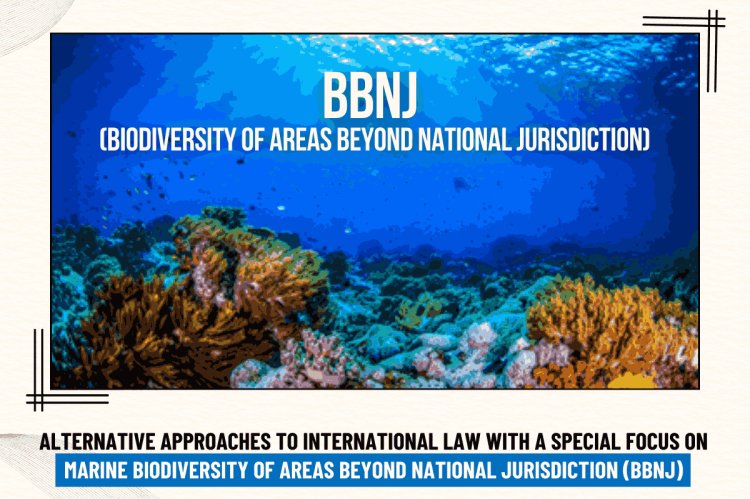Alternative approaches to International law with a special focus on Marine Biodiversity of Areas Beyond National Jurisdiction (BBNJ)
The governance of marine biodiversity in areas beyond national jurisdiction (BBNJ) has become a pressing issue as overfishing, pollution, and climate change threaten these ecosystems. The current frameworks under international law are largely fragmented, resulting in ineffective protections. This article explores alternative approaches to international law that could enhance BBNJ protection, including ecosystem-based management, the common heritage principle, and adaptive governance models. Through these approaches, we analyze the potential to balance conservation efforts with sustainable resource utilization, offering a holistic pathway for governing these critical ocean areas beyond national borders.

INTRODUCTION
Marine biodiversity beyond national jurisdiction (BBNJ) encompasses the vast oceanic areas that lie outside the jurisdictional reach of any single nation. These areas, covering nearly half of the planet's surface, play a vital role in global ecological balance, providing essential resources and ecosystem services such as climate regulation, fisheries, and biodiversity. However, human activities—ranging from overfishing to deep-sea mining—pose increasing threats to these ecosystems, necessitating an international approach to governance.
Traditional approaches to international law, including the United Nations Convention on the Law of the Sea (UNCLOS), provide a basis for managing certain aspects of the high seas. Yet, these frameworks often lack cohesion, leaving significant gaps in marine conservation efforts. As countries negotiate a new legally binding instrument to govern BBNJ under UNCLOS, there is an urgent need to explore alternative approaches that could offer more effective solutions. This article delves into alternative governance models for BBNJ, including ecosystem-based management, common heritage principles, and adaptive governance, assessing their potential to enhance the conservation and sustainable use of marine biodiversity in these vulnerable areas.
Background: Challenges in Governing BBNJ
1. The Limitations of UNCLOS
Adopted in 1982, UNCLOS established the legal framework for ocean governance, covering territorial seas, exclusive economic zones (EEZs), and the high seas. While UNCLOS provides guidelines on marine resource management and pollution control, it does not address the complex and interconnected nature of marine ecosystems. Additionally, UNCLOS focuses on state sovereignty and jurisdiction, which limits its capacity to manage transboundary and high-seas biodiversity effectively.
2. Fragmented Governance and Gaps in Protection
Current BBNJ governance relies on various regional organizations and sectoral agreements, such as the Convention on Biological Diversity (CBD) and the International Maritime Organization (IMO). However, these agreements are often fragmented, lacking coordination and consistency in conservation and management strategies. For example, fishing activities may be governed by regional fisheries management organizations (RFMOs), while marine pollution is under the purview of the IMO. This fragmentation results in jurisdictional overlaps and legal loopholes, undermining effective BBNJ protection.
3. Emerging Threats to BBNJ
As technological advancements allow for deeper ocean exploration, activities like deep-sea mining, bioprospecting, and seabed drilling pose new threats to BBNJ. These activities, combined with climate change-induced stressors, risk destabilizing marine ecosystems, reducing biodiversity, and impacting the livelihoods of millions who depend on the ocean. Without a cohesive legal framework, these activities continue to operate in a regulatory vacuum.
Alternative Approaches to International Law for BBNJ Governance
To address the limitations of current frameworks, several alternative approaches to international law have been proposed. These approaches offer comprehensive methods for enhancing the conservation and sustainable use of marine biodiversity in areas beyond national jurisdiction.
1. Ecosystem-Based Management (EBM)
Overview: Ecosystem-based management (EBM) is a holistic approach that considers entire ecosystems, including humans, rather than focusing on individual species or sectors. By prioritizing ecosystem health and resilience, EBM aims to maintain ecological balance and biodiversity.
Application to BBNJ: EBM could transform BBNJ governance by emphasizing the interconnectedness of marine ecosystems. This approach would require international collaboration to develop cross-sectoral policies that account for ecological processes and species interactions across boundaries. EBM could also establish ecological baselines to evaluate the impact of human activities, enabling adaptive responses to protect biodiversity.
Benefits: EBM reduces the risk of fragmented governance by integrating different sectors—fisheries, mining, and shipping—into a unified management framework. This approach promotes a long-term vision for marine conservation, addressing cumulative impacts and providing flexibility to adapt to changing environmental conditions.
2. The Common Heritage of Mankind Principle
Overview: The common heritage of mankind (CHM) principle asserts that certain areas, including the high seas and outer space, are part of the global commons and should benefit all humanity. This principle suggests that resources in these areas should be used sustainably and preserved for future generations.
Application to BBNJ: Adopting CHM for BBNJ would imply shared stewardship of ocean resources, limiting exploitative activities and ensuring equitable access to benefits. This approach could lead to the establishment of a global trust for BBNJ resources, directing a portion of revenue from activities like bioprospecting toward conservation and equitable distribution.
Benefits: The CHM principle supports fair and inclusive governance, recognizing the high seas as a shared responsibility. It aligns with sustainable development goals, ensuring that resource use is balanced with conservation and community benefit. This approach also encourages cooperation among nations, promoting solidarity in tackling global environmental challenges.
3. Adaptive Governance
Overview: Adaptive governance is a dynamic approach that accommodates environmental uncertainties and changes through continuous learning and flexible policy adjustments. Unlike traditional regulatory systems, adaptive governance involves stakeholders in decision-making, allowing for collaborative problem-solving.
Application to BBNJ: Adaptive governance could provide a flexible framework for managing BBNJ by establishing mechanisms for monitoring, feedback, and policy adjustment. This model would enable international bodies to respond proactively to emerging threats, such as climate change impacts on marine ecosystems, and adapt conservation strategies accordingly.
Benefits: Adaptive governance fosters resilience by integrating scientific research, traditional knowledge, and stakeholder input into policy decisions. This approach enhances transparency and accountability, empowering communities, scientists, and governments to collaborate on preserving marine biodiversity effectively.
4. High Seas Marine Protected Areas (MPAs)
Overview: Marine protected areas (MPAs) are designated zones where human activities are restricted to protect biodiversity. Expanding MPAs into the high seas could shield vulnerable ecosystems from overfishing, pollution, and habitat destruction.
Application to BBNJ: Creating MPAs in BBNJ would require international agreements to establish legally binding protections for high-seas ecosystems. These MPAs could function as ecological refuges, providing safe habitats for species and preserving genetic diversity. MPAs can be integrated into existing legal frameworks through amendments or new international agreements under UNCLOS.
Benefits: MPAs support biodiversity conservation, contribute to fish stock recovery, and protect habitat integrity. By implementing MPAs in BBNJ, countries could safeguard critical areas, ensuring ecosystem resilience in the face of climate change.
5. Global Biodiversity Fund for BBNJ Conservation
Overview: Establishing a dedicated fund for BBNJ conservation could provide financial resources for research, monitoring, and enforcement. Such a fund would operate as part of a global mechanism, pooling resources from various stakeholders.
Application to BBNJ: A BBNJ-focused fund could support developing countries in marine conservation initiatives, ensuring that resource-limited nations can contribute to global ocean governance. The fund could also finance technology and infrastructure needed for monitoring BBNJ areas effectively.
Benefits: A global biodiversity fund would address financial disparities, enabling equitable participation in BBNJ conservation. By providing consistent funding, this approach ensures that countries have the resources to implement sustainable management practices.
Implementing Alternative Approaches: Challenges and Opportunities
1. Legal and Institutional Challenges
Implementing alternative governance models requires overcoming legal, political, and institutional hurdles. Establishing common ground on issues like benefit-sharing, compliance, and enforcement will be essential for effective BBNJ governance.
2. Coordination Among Nations
Effective BBNJ governance depends on international collaboration. Developing a consensus among diverse stakeholders—countries, industries, and non-governmental organizations—will be necessary to implement alternative approaches.
3. Scientific and Technological Capacity
BBNJ management requires robust scientific research and advanced technology to monitor ecosystems. Building capacity for data collection and analysis, especially in developing countries, will be crucial for evidence-based policy-making.
4. Public Awareness and Engagement
Raising awareness about BBNJ’s importance can foster public support for conservation efforts. Engaging stakeholders, including indigenous communities and industry players, will promote inclusive governance.
CONCLSION
As threats to marine biodiversity beyond national jurisdiction escalate, alternative approaches to international law offer promising pathways for effective governance. By adopting ecosystem-based management, the common heritage principle, adaptive governance, MPAs, and a global biodiversity fund, the international community can strengthen protections for BBNJ, ensuring sustainable resource use and conservation.
A holistic approach to BBNJ governance requires not only legal innovation but also collaboration, capacity-building, and financial investment. As negotiations continue under UNCLOS, exploring these alternative models will be essential for establishing a resilient framework that supports both environmental sustainability and equitable resource distribution. Protecting BBNJ is not only a legal imperative but also a moral responsibility to future generations, underscoring the need for transformative












